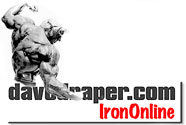Exercise Instruction
How to Squat
Folks, I don't do squats because no one ever showed me how, and (sheepish) after I was 35, I hated to admit I have never done them and ask someone to show me the correct form.
How about the easy intro? Anyone who's never done squats before, stand up. Seriously, just stand up right there in front of your monitor and let's go through this.
Move your feet so they're just slightly wider than shoulder width apart. Point your toes out, just slightly. After you've played around with this, you can adjust your foot positioning to suit your structure.
Grab your legs near the lower quads, right hand on right leg, left hand on left - in other words, put your hands slightly above your knees. Take a deep breath of air, filling your chest. This forces your back into a straight line from neck to tailbone as you don't want a rounded back when squatting.
Looking slightly downward at a point six or eight feet forward, raise your hands out straight in front of you.
Keeping your weight on your heels and your feet flat on the floor, lower yourself another 10 inches.
With your hands still in front of you, lift yourself to an upright position using your upper leg muscles.
Lower yourself and repeat. Perfect squats. There's absolutely no better way to learn or teach squats than from the BOTTOM UP as opposed to the top down.
To change this from well-formed deep knee bends to barbell squats, position the safety bars of the squat rack at a spot just slightly below your shoulders. If you're using a solid pin squat rack, put the bar on the pins nearest your shoulder height. Remember the movements we did in front of the computer and perform them now, without the bar, both to remember the motion and to warm up your knees, hips, ankles and leg muscles.
Step up to the empty bar and wrap your hands around the bar in a comfortable spot. Most people end up with their hands about a foot wider than their shoulders, usually using the bar's knurled edge or grip ring to find an even position so that your body is centered under the bar. For back squats, step under the bar and bring your upper body backwards into contact with the bar, knees slightly bent. Shuffle around slightly - leave the bar on the rack but schooch (hmmm?) around until you find that sweet spot where the bar just sits on the shelf created by your traps when your arms, elbows and chest are all held high from concentration and a big breath of air.
Straightening your knees to bring your body upright and the bar off the rack, back away from the pins so you're a couple of feet away. Position your feet again - slightly wider than shoulders, toes pointed out. Look straight forward, chest high, elbows high, big air and lower yourself into a deep knee bend. Your first squat may not be very deep, but as you become more comfortable with the bar on your back and your ability to come back up, you'll move deeper and deeper into what the powerlifters call "the hole."
Your flexibility will increase fairly quickly, your confidence even quicker. Your muscles will become conditioned to the movement within a few sessions and your ankles, hips and knees will get stronger over the next month or so, when you'll find yourself with the desire to ADD MORE WEIGHT!
Your hip mobility, both the flexibility of in the hips and your muscular strength in the hip region, will determine your ability to squat deeply and well. Hip mobility is key for most aspects of physical ability.
Main thing to remember: how far you go down should be dictated by your ability to come up... no! that's not what I meant to say!!... Seriously, how far you go down should be dictated by your ability to keep your back straight. I'm not referring to upright, but forming what's called a neutral spine - a straight line from neck to tail bone. Start back up just before the point when you round your back. This point will be lower and lower as time goes by - as your back gets stronger and your flexibility increases. A little patience here will save your back from injury.
Another thing I'm trying to be aware of is the difference between pushing thru the heel and pushing thru the ankle. To help a new squatter hold their balance, we usually say, "push thru the heel" to keep their weight back, rather than forward onto the toes. More accurate would be to press thru the ankle, which will better distribute the force of the weight during the movement.
Well, that's the end of the seminar for today. Grab a ride over to this link for a discussion of the head angle during squatting; head angle affects the spine... this is an important element.
Laree
CLICK HERE FOR IRONONLINE ARCHIVE
And now where may I drop you?
May we answer any bodybuilding questions for you in our forum?
If you haven't yet read Dave's bodybuilding book, Brother Iron, Sister Steel, here's more information.
You may also enjoy our ongoing weight training and fitness article blog, which we update with new material several times each week.
Are you in the mood for reading an weight training book excerpt?
Can I tell you about whey protein powders?
Could you use a new 8-week workout routine or a bodypart workout program? Need to learn how to squat or how to deadlift?
Or select a link to the right to discover our most popular pages that are sure to answer all your training questions.

